Bromide

Parameter Type: Drinking Water Testing for Volatiles
Parameter Name: Bromide
What it is and Where it Comes From:
Bromide is the more stable form of the element Bromine. The atomic number for Bromine is 35 and the symbol Br, it belongs to the highly reactive halogen group, which includes fluorine, chlorine, and iodine. Halogens are oxidizing agents that form anions by accepting an electron (their outer electron shell is one electron short of being full). Bromine is found naturally in the earth’s crust, underwater brines, salt lakes, and in seawater in various chemical forms. Metals react with bromine to form bromides. It is soluble in organic solvents and water and can be found in fumigants, dyes, flame proofing agents, water purification compounds, vegetable oils, and more. Bromine substances are disinfectants and can be used as an alternative for chlorine. In swimming pools and hot tubs, bromine salts are used against the formation and growth of algae, bacteria, and odors in swimming water. Safe Home offers Laboratory drinking water testing kits for bromide, allowing you to collect your water sample and ship it directly to our EPA-Certified Laboratory. This platform of drinking water testing for bromide will give you an accurate level based on the lowest level of a parameter our instruments can detect (Method Detection Level). Safe Home drinking water testing for inorganics can be used for city and well water supplies. Drinking water testing should be done any time you notice a significant change in your water quality.
Health Effects:
Drinking water testing for bromide is not recommended for childbearing women, those with kidney issues, and children. People who ingested large amounts of bromide may experience gastrointestinal symptoms such as nausea, vomiting, diarrhea, and abdominal pain. Chronic exposure to bromide can cause bromism, a condition with symptoms including neurological effects (restlessness, irritability, ataxia, confusion, hallucinations, psychosis, weakness, stupor, and coma), skin rashes. Some individuals who ingested high concentrations of bromide also experienced kidney effects, nervous system effects and hearing loss. However, these people were exposed to bromide levels thousands of times the amount that would come from drinking water at its standard. Because bromide can cause health effects in kidneys, it is possible that those with pre-existing kidney conditions could be at greater risk. Individuals who may be more susceptible include women of childbearing age and children. Keep in mind that bromide in small amounts prove to be harmless and if only ingested in large amounts proves harmful to the human body.
Solutions to Contaminant Levels:
Wondering how to remove bromide in your water after drinking water testing? Bromide can be removed from drinking water with a Reverse Osmosis System, with a removal rate of around 95%. Reverse osmosis is a process that removes foreign contaminants, solid substances, large molecules, and minerals from water by using pressure to push it through specialized membranes. Here’s how reverse osmosis works. Unlike osmosis, which is a passive process, reverse osmosis requires external force (pressure) to work. Pressure is applied to a highly concentrated solute solution, such as salt water, to pass through a membrane to a lower concentrate solution. The membrane allows water to flow through but blocks out larger molecules, like contaminants. The reverse osmosis process leaves higher concentrations of solute on one side and only the solvent, or freshwater, on the other. Who do I need to contact to find out more information about water quality in my area? Every community water supplier must provide an annual report to its customers, known as a Consumer Confidence Report (CCR). The report provides information on your local drinking water quality, including the water’s source, contaminants found in the water, and how consumers can get involved in protecting drinking water. How often does the local public water system preform drinking water testing? Frequency of drinking water testing depends on the number of people served, the type of water source, and types of contaminants. Certain contaminants are tested more frequently than others, as established by the Safe Drinking Water Act. You can find out about levels of regulated contaminants in your treated water for the previous calendar year in your annual Consumer Confidence Report (CCR).


